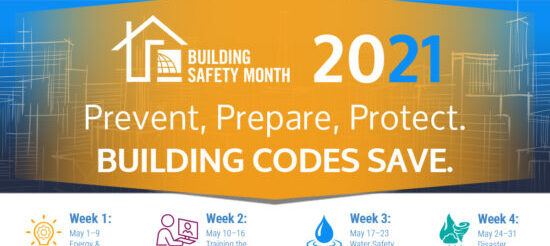Building Safety Month 2021 Highlights Energy and Innovation In Unlocking a Sustainable Future

From fueling our businesses to powering our technologies, energy has always been a vital part of society. Yet, energy use and associated greenhouse gas (GHG) emissions can pose significant challenges to communities, homeowners and renters, and business owners. With the increasingly visible impact of a changing climate including the worsening frequency and intensity of disasters, it is abundantly clear that, as a society, we must commit to enhanced levels of energy performance and overall sustainability.
Recognizing this, the new U.S. administration has begun releasing a series of executive orders and resolutions aimed at helping make the U.S. more energy efficient – starting with buildings. After all, buildings account for about 40% of all U.S. energy consumption and a similar proportion of greenhouse gas emissions. Luckily, modern and innovative building codes and standards can help to address this, along with laying the foundation for creating safe, sustainable and resilient communities.
To raise awareness around the important role of building codes and standards, Building Safety Month – a month-long annual educational campaign in May hosted by the International Code Council, its members and partners – devoted its week one theme to Energy and Innovation.
The Role of Building Codes and Standards in Advancing Resiliency and Efficiency
There are many benefits to an energy efficient society but the two biggest are environmental and economic. According to a recent study from the Federal Emergency Management Agency (FEMA), if all new buildings across the U.S. were built to modern editions of the International Codes (I-Codes), the country would save more than $600 billion by 2060. The U.S. Department of Energy (DOE) estimates that through 2040 energy codes and standards could save $126 billion in energy costs, equivalent to the emissions of 177 million passenger vehicles, 245 coal power plants or 89 million homes.
Yet, even with these clear benefits, that same FEMA study found that 65% of counties, cities and towns across the U.S. have not adopted modern building codes. With communities across the world continuing to grow, creating efficient and resilient communities has never been more important. It is not only about keeping the cost of energy bills lower with innovative designs, but it is also about creating a structure that can withstand the forces of nature and can come back after a disaster without needing to be completely rebuilt.
The Code Council Lays the Foundation for Communities
Understanding we are in a race against time to address these pressing matters, the Code Council recently released its new framework, Leading the Way to Energy Efficiency: A Path Forward on Energy and Sustainability to Confront a Changing Climate, to build off the success of its International Energy Conservation Code (IECC) and provide communities with additional tools to help reduce greenhouse gas emissions.
The IECC already provides a strong basis for reaching building energy efficiency goals, with base energy efficiency requirements in the 2021 IECC only 10% away from net zero for residential buildings. Each future edition of the IECC will build on this as the revised scope and intent set clear commitments moving forward – including no rollbacks in energy savings from edition to edition, requirements to include pathways to achieve zero energy buildings today and by 2030, and the ability to incorporate strategies for decarbonization, electrification and electric vehicle charging. With the IECC at its core, this new framework provides a multi-pronged approach to deliver the energy efficiency and other GHG reduction strategies we need.
As we wrap up another Building Safety Month, local governments and sector leaders can confidently come away with a better understanding and awareness of the positive impact of building codes and standards, especially the IECC, and how they can utilize these codes and standards to lead a change in their communities.
After all, local adoption of updated and advanced building codes and standards, when used to their fullest extent, have a tremendous amount of value to the long-term health and safety of our communities.
Ryan Colker is the Code Council’s Vice President of Innovation. Colker works to identify emerging issues in the building industry, including how new technologies can be leveraged by codes and standards, methods to modernize the application of building regulations, and the development of new business strategies that support members and building safety professionals. He also serves as executive director of the Alliance for National and Community Resilience.
